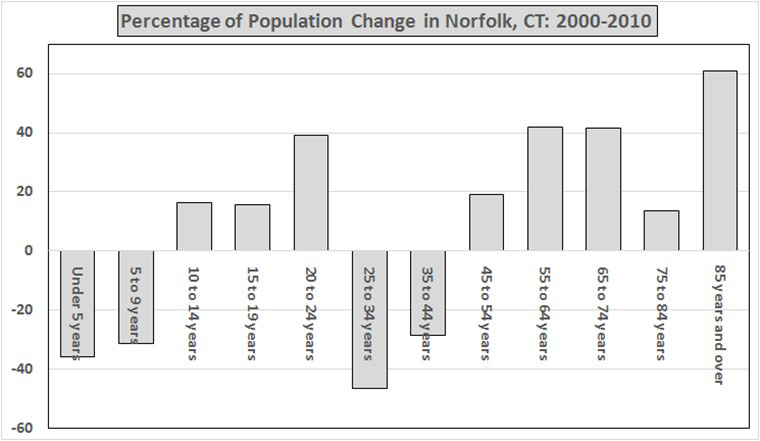Analysis of Norfolk’s Population Changes Reveals Surprises
Periodic increases and decreases evident
By Joshua DeCerbo

Much of the talk leading up to “Norfolk 2023!,” when, on October 12, the town takes stock of the future, presumes that the town is losing population, along with much of Litchfield County and the rest of the state. But an analysis of several population databases from the U.S. Census Bureau reveals three significant and unexpected findings.
Over the decade ending in 2010, Connecticut’s total population grew by five percent, Litchfield County grew by four percent and Norfolk’s population grew by half a percent. The main reason for this increase is that births in Connecticut have outpaced deaths and losses due to people moving out of the state.
A second popular assumption is that Litchfield County, and the state in general, is getting older. The data reveals a more complex picture, with periodic increases and decreases in population. Perhaps most surprisingly, there is a second mini-baby boom generation that is just beginning to enter their prime reproductive years, likely signaling an increase in birth rates in the near future.
Today, there is a greater number of older people in the Northwest Corner than was present ten years ago. The median age of the population in Litchfield County has increased from 39.6 years in 2000 to 44.4 years in 2010, making it the oldest county in Connecticut. Norfolk’s population, with a median age of 47.5 years in 2010, is even older.
Much of this aging stems from generational differences in birth rates, and the positive effect that modern medicine and lifestyle changes have had on longevity. Also, as the Baby Boomer generation has gotten older, it has pushed the median age of the population upward.
However, Norfolk has seen a much greater expansion of people in the oldest age groups than those seen across the rest of the state. The population of the 65-74 age group has increased by more than four times the state average, while the 85 and older age group has increased at a rate that is twice that seen across Connecticut.
Across the state, the number of people in the 25-44 age group has decreased since 2000, mainly due to the fact that there were fewer people born in this generation than during the preceding baby boom.
However, Norfolk has also seen a much greater decrease in the 25-44 year age group than the state average. For example, there were approximately half the number of people aged 25-34 living in Norfolk in 2010 than were present in 2000.
This loss has happened at a rate that is more than six times faster than the state average, and 2.5 times faster than in Litchfield County as a whole. Consequently, as there are a lower number of young parents, the population of Norfolk’s children under ten, many of whom are enrolled in Botelle School, has steadily decreased by about 30% over the same age group ten years before.
Countering this trend is the fact that throughout Connecticut, the data reveals that there was a mini baby-boom between the years of 1985 and 2000. Given that the members of this group are about to enter their prime reproductive years, they are likely to produce a greater number of children in the near future. This reflects the fact that population increases and decreases happen on a cyclical and generational basis, and have not simply continued to plummet since the onset of the Baby Boomer generation.
Another conclusion drawn from the census data is that Connecticut, like much of the country, has seen a relatively rapid increase of ethnic and racial minority populations since the year 2000. Litchfield County is the least ethnically-diverse county in the state, with only 6% of its population that did not self-identify as being white.
Between 2000 and 2010, the white population decreased by 0.3 percent, especially within urban districts. Over the same time period, the black and African-American population in the state increased by 17 percent, The Asian population increased by 65 percent, and the Hispanic or Latino population by 34 percent statewide. The number of Hispanic and Latinos in Litchfield County more than doubled during that time. It is clear that Connecticut, like much of America, is undergoing a measurable and significant change in its sociocultural demographics.
